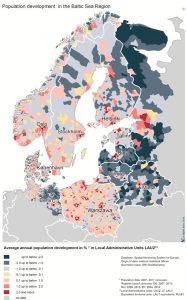Map on Population in the Baltic Sea Region
Where the number of population in the Baltic Sea Region is growing or shrinking
Following an analysis on population development of European municipalities (LAU 2), a similar investigation was carried out for the Baltic Sea Region with support from the VASAB network. That analysis comprised all EU countries in the Baltic Sea Region (in Germany – the northeastern part) as well as Norway, Belarus and Northwest Russia. The analysis reveals large disparities of population development.

The South and West is growing – the North and East shrinking
Declining population figures can especially be observed in the northeastern part of Baltic Sea Region (parts of Lithuania, Latvia, Belarus and Russia as well as northern areas of Norway, Sweden and Finland) and in East Germany. Contrary to that, highest increases are visible for large parts of Poland as well as southern areas of the Nordic countries. The positive population development in large areas of southwestern Baltic Sea Region is mainly caused by in-migration from the northeastern countries and by regional migration, in Poland also by positive natural population change.
Urbanisation and suburbanisation
All areas are characterised by positive population development of metropolises, capital cities and other larger cities which is mainly caused by gains from migration. In the southwestern Baltic Sea Region often both, the metropolises and cities as well as their surrounding areas show a positive population development. In the southeastern Baltic Sea Region with previously more compact cities, the suburbanisation processes started later. Here, surrounding areas of cities showed an even stronger growth of population figures. Nearly all larger cities in Poland and capitals of the Baltic States show distinctive suburbanisation tendencies with even population declines in centres and a partly very strong growth in the surrounding municipalities. Suburbanisation is also evident for St.Petersburg, Minsk, Kaliningrad, Pskow and Nowgorod however, not as clearly visible as in Poland, Denmark and Germany because of the larger territorial monitoring units (rayon).
Rural exodus
As already shown in the VASAB Long Term Perspective for Territorial Development of the Baltic Sea Region, the development of cities happens at the expense of rural municipalities and regions. The partly strong population declines in sparsely populated regions indicate a migration trend “from the countryside to the city”. In medium term, rural areas, which featured over a long period a positive natural population change, will not be able to maintain a sufficient potential for population reproduction. In the Nordic countries, in Poland and Germany and partly in Estonia, smaller cities inside rural areas still show a certain population growth however, at the expense of surrounding rural settlements. This process cannot be featured in detail Russia and Belarus and partly not in the northern parts of the Nordic countries, in Lithuania and Latvia because of the incommensurability of territorial units and different available time horizons.
Some conclusions
Content-wise, the above-mentioned trends can to some extent be attenuated through a more polycentric settlement development as for instance in Poland, Germany and Denmark. This needs to be accompanied by flexible solutions in the provision of services of general interest, by creation of new economic development alternatives for rural areas and by more intensive urban-rural cooperation and partnerships. Especially, metropolises need to assume a greater responsibility for surrounding areas also in their wider vicinity.
From the methodological perspective, there is a need to enable more long-term comparisons at a more comparable territorial basis in order to monitor intra-regional development trends and their consequences. So far, the Local Administrative Units of level 2 (LAU 2) of Germany, Poland and Denmark can hardly be compared with the respective LAU 2 of EU States in the region and even less with Russia and Belarus. In principle, rayons of Russia and Belarus can be compared with NUTS 3 of other states in the Baltic Sea Region. In some cases (Nordic countries) also LAU 1 is suited. It might be an option, to mix different monitoring units towards better comparability. Moreover, it needs to be investigated on whether some indicators can be obtained at a lower regional level for Nordic countries (for instance tätorter and småorter for Sweden and taajamas for Finland) and for Russia and Belarus. This is especially valid for monitoring urban-rural population change. The existing Territorial Monitoring System for the Baltic Sea Region, its further development and support structures provide a good basis for respective efforts.
Contact:
Wilfried Görmar, Volker Schmidt-Seiwert, Regine Binot for EU-countries
Nina Oding, Alena Kasyanenka for Russia and Belarus – all via info@vasab.org



